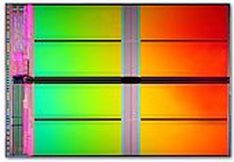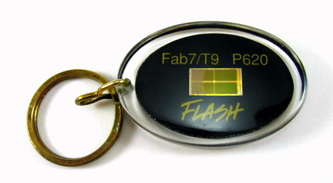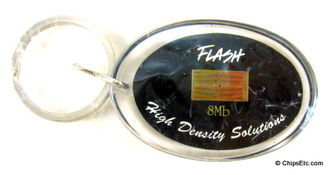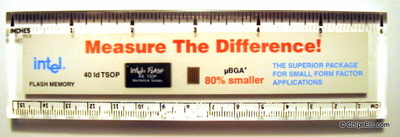Flash Memory

Intel 32GB Flash Memory Chip (2008)
Flash memory, and advanced form of EEPROM memory, was invented in 1980 by Dr. Fujio Masuoka of Toshiba Semiconductor.
Flash memory is a high-density, high-speed, non-volatile, semiconductor memory that can be electrically erased and reprogrammed by accessing large blocks of it's memory to allow for very fast read access times.
There are two distinct types of Flash memory technologies, NAND, and NOR. NOR flash memory is used for storing code and execution. NAND flash memory is used for data storage.
In 1987, Toshiba launched the sale of the first commercially available flash memory chip, using there NAND flash technology. A year later in 1988, Intel would introduced the first commercial NOR flash memory chip with hopes of it being a replacement for their aging ROM (Read Only Memory) technology used on computer motherboards.
Many semiconductor companies have since competed with Intel in the highly competitive Flash memory market, including: Seeq Technology, AMD, Micron, M-Systems, Fujitsu, Samsung, Toshiba, Motorola, Infineon and quite a few others.
From the late 1990's through today, Flash Memory (NAND) is most often found as removable memory-card storage for use in portable electronic devices (iPods, smartphones, and digital cameras), USB Flash Drives & Solid-State Drives (SSD) to store data of images, programs, & music.
In 2020, Intel announced plans to sell off it's NAND and SSD business group to Korean memory chip manufacturer SK Hynix.
Flash memory is a high-density, high-speed, non-volatile, semiconductor memory that can be electrically erased and reprogrammed by accessing large blocks of it's memory to allow for very fast read access times.
There are two distinct types of Flash memory technologies, NAND, and NOR. NOR flash memory is used for storing code and execution. NAND flash memory is used for data storage.
In 1987, Toshiba launched the sale of the first commercially available flash memory chip, using there NAND flash technology. A year later in 1988, Intel would introduced the first commercial NOR flash memory chip with hopes of it being a replacement for their aging ROM (Read Only Memory) technology used on computer motherboards.
Many semiconductor companies have since competed with Intel in the highly competitive Flash memory market, including: Seeq Technology, AMD, Micron, M-Systems, Fujitsu, Samsung, Toshiba, Motorola, Infineon and quite a few others.
From the late 1990's through today, Flash Memory (NAND) is most often found as removable memory-card storage for use in portable electronic devices (iPods, smartphones, and digital cameras), USB Flash Drives & Solid-State Drives (SSD) to store data of images, programs, & music.
In 2020, Intel announced plans to sell off it's NAND and SSD business group to Korean memory chip manufacturer SK Hynix.



